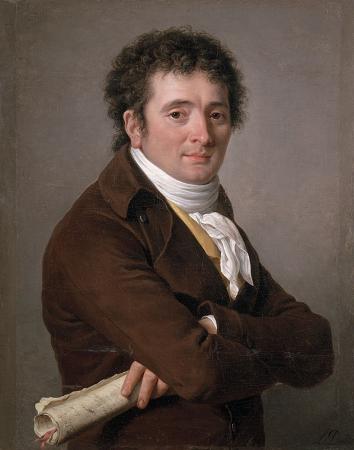Adelaide Labille-Guiard (1749 - 1803). Adelaide Labille-Guiard, also known as Adélaide Labille-Guiard des Vertus, was a French miniaturist and portrait painter. She was an advocate for women to receive the same opportunities as men to become great painters. Labille-Guiard was one of the first women to become a member of the Royal Academy and was the first female artist to receive permission to set up a studio for her students at the Louvre. Labille-Guiard became a master at miniatures, pastels, and oil paintings. Little is known about her training due to the practices of the 18th century which dictated masters should not take on female pupils. During this time, females were perceived as incapable to follow instruction alongside men. During adolescence, Labille-Guiard studied miniature painting with oil painter François-Élie Vincent and her early work was exhibited at the Académie de Saint-Luc. She apprenticed with the pastel master Quentin de la Tour until 1774. Exhibitions at the Académie de Saint-Luc. Labille-Guiard was admitted to the Académie de Saint-Luc in 1767 when she was twenty years old. Her admission piece has since disappeared and sadly no records of its existence survive today. The Académie de Saint-Luc provided Labille-Guiard with a space to practice art professionally. In 1774, she exhibited her work at its Salon. This show was so successful that the Royal Academy took offence, and with the backing of the monarchy, issued an edict in March 1776 abolishing guilds, brotherhoods, and communities of arts and crafts, forcing the Academie de Saint-Luc to close its doors in 1777. However, this did not stop Labille-Guiard's ambitions as an artist. Becoming a member of the Royal Academy. Once the Académie de Saint-Luc closed its doors, Labille-Guiard began to learn oil painting so she could apply to the Royal Academy which required her to present at least one oil painting for admission. Labille-Guiard chose to display some of her work at the Salon de la Correspondance in 1779. This included her self-portrait in pastel and oil portraits which were well received by critics. Labille-Guiard's talent as an oil painter and pastellist was quickly noticed and she received national recognition ultimately leading to her acceptance into the Royal Academy. On May 31, 1783, Labille-Guiard was accepted as a member of the French Academie Royale de Peinture et de Sculpture. Three other women were admitted as members on the same day. Becoming accepted into the Royal Academy opened doors for Labille-Guiard as she gained patronage from the royal family. Painter for the Royal Family. Through pure artistic ability and talent, Labille-Guiard became a painter for the Royal family. Her royal patrons included the aunt of Louis XVI of France, Princess Marie Adélaide and her sister Victoria Louise, and the King's sister Elizabeth and earned her a government pension of 1,000 livres. The portrait of Adelaide completed in 1787 was one of Labille-Guiard's largest and most ambitious work to that date. She was later commissioned in 1788 by the King's brother, the Count of Provence. She was instructed to paint him at the centre of a large historical work, Reception d'un chevalier de Saint-Lazare par Monsieur, Grand maître de l'ordre. In 1795 she obtained artist's lodging at the Louvre and a new pension of 2,000 livres. She was the first woman artist to be permitted to set up a studio for herself and her students at the Louvre. Paris society portraits by Adelaide Labille-Guiard. Labille-Guiard often did not fit comfortably within the boundaries of feminine virtue in the 18th century. In order to appeal to a wide variety of viewers including upper-class men and women, she often incorporated recent fashions into her paintings which allowed her to showcase her artistic ability. She was good at rendering details, such as showing luxurious folds and layers of complex skirts that were in fashion at the time. However, often she painted with a twist such as having women face directly at the viewer or with a low neckline, which was an uncommon practice in the 18th century when portraying women. Further evidence of Labille-Guiard's boldness can be seen in her self-portraits which leave her exposed slightly more than usual, but not enough to evoke allegations of promiscuous behaviour. This is seen in her painting Self-Portrait with Two Pupils. Unlike some other paintings of female artists in the 18th century, Labille-Guiard chose to depict herself actively working rather than passive and at rest. Labille-Guiard also pushed against other restrictions, such as those that limited the number of females that could attend the Royal Academy.
more...










